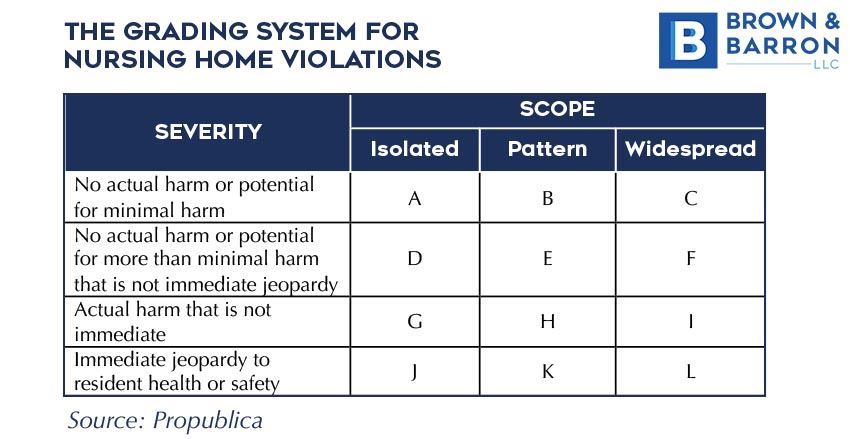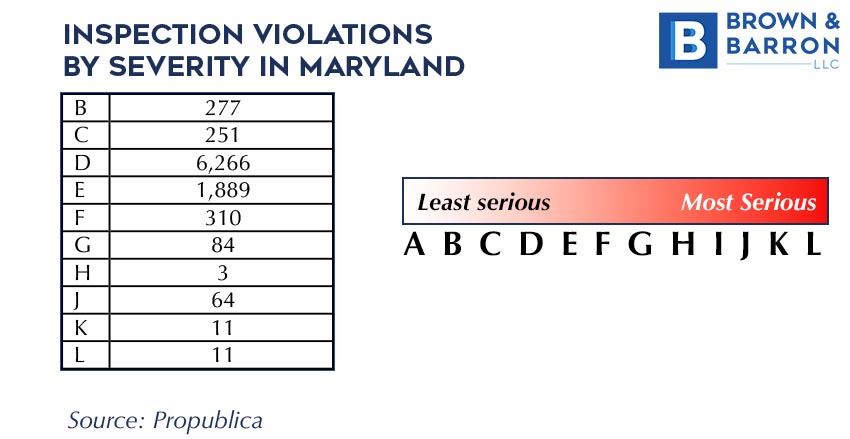In school, the dreaded “F” is rock bottom on a report card, but in nursing home inspections, the worst facilities take an “L.” Nursing homes get a yearly surprise inspection to help ensure the facility is providing adequate care. Every nursing home must comply with federal and state regulations, including standards for cleanliness, infection controls, staffing levels and training, and quality of life issues, among others. Every violation of the regulations is given a letter grade from “A” to “L,” based on the 1) severity of the issue, and 2) the scope of the problem, that is, how long the issue has gone uncorrected and/or how many people were impacted.
To schedule a free case review with a nursing home abuse & neglect lawyer serving Baltimore, call Brown & Barron at (410) 698-1717 or contact us online today!
If you want more articles like this, subscribe to our free monthly newsletter by clicking here.
The Deficiencies Matrix
In government inspections, the “A” through “L” Deficiency Matrix has four tiers of nursing home violations:
- Tier 1 Violations (A, B, C): No actual harm or potential for minimal harm
- Tier 2 (D, E, F): No actual harm or potential for more than minimal harm that is not immediate jeopardy
- Tier 3 (G, H, I): Actual harm that is not immediate
- Tier 4 (J, K, L): Immediate jeopardy to resident health or safety
In each of the tiers, the three letter grades depends on whether the violation was 1) an isolated incident, 2) a pattern of the same violations, or 3) a widespread problem

Examples of Actual Violations for the Four Levels of Severity
The following are excerpts from a single inspection of one Maryland nursing home in June of 2021, in which the facility was found to have 22 deficiencies and was fined over $133,000, including a suspension of payment. The inspection gives a real-world insight into the violations found by inspections…
Level A – C: Resident Neglected in Urine & Feces
“During a tour of the Nursing Unit 2, the Surveyor smelled a strong urine smell in the hallway that came from Resident #21’s room. The Resident #21 was observed on his/her side asleep. Observations of the back of Resident #21’s bed gown revealed the gown was saturated with urine, there was a brown dried stain around the saturated area. The resident’s adult brief was expanded which indicated the brief was full. Resident #21’s linen appeared to be saturated with urine.”
Level D – F: Resident’s Medical Orders Not Followed
“A medical record review … revealed that the Nurse Practitioner’s order was for Resident #105 to see a cardiology (heart specialist) and gastrointestinal (digestive system specialist) for consultation. Further review of the resident’s revealed that Resident #105 had an order for a cardiology consult on 4/28/21. There had been no evidence that Resident #105 had been seen by a Cardiologist since the initial order on 4/28/21. In addition, there was no evidence that Resident #105 had an appointment scheduled to see a cardiology or a gastrointestinal for consultation as ordered on 5/20/21. An interview with Unit Secretary (US) Staff #42 on 6/22/21 at 2:30 PM, revealed US Staff #42 was unaware of Resident #105’s orders for cardiology and gastroenterology consults.”
Level G – I: Resident’s Bedsore Skin Graft Torn Off
“…the Nurse Practitioner (NP) stated he/she was made aware on 06/07/2021 of the resident’s concern that his/her skin graft was removed during a dressing change on 06/04/2021. The NP stated he/she was aware the surgical dressings had been removed and replaced by a staff member. The NP stated he/she spoke with the facility’s Medical Director who advised to not remove the dressing to assess the right heel because the resident had a follow-up appointment with the surgeon the next day on 06/08/2021. The surveyor asked where the NP documented his/her note regarding the 06/07/2021 visit, the NP stated he/she failed to document the visit. During a phone interview on 06/21/21 at 12:11 PM, the surgeon stated the consequence of the removal of the skin graft is a failure of the skin graft procedure.”
Level J – L: Patient Death Reveals that Multiple Resident Rooms Have Wrong Chart or No Chart
“Resident #100’s chart was in Resident #127’s chart slot. Rooms #101, 105, 121, and 127’s were not labeled with the resident’s name door. Unit Two The chart for the resident residing in room [ROOM NUMBER] were in the chart slot designated for the resident residing in room [ROOM NUMBER]A. The chart for the resident in room [ROOM NUMBER]B was in the chart slot designated for the resident residing in room [ROOM NUMBER]A. Rooms 207, 212, 216, 221’s did not have the name of the resident posted outside of the door.”
Who Determines the Grade?
Although most nursing homes are privately owned, they get most of their revenue from the U.S. government, through Medicaid and Medicare. If they want to participate, they must follow the Centers for Medicare & Medicaid Services (CMS) regulations to ensure residents are receiving quality care and submit to annual unannounced inspections, as well as other inspections (i.e., to follow up on a violation, complaint, or other evidence of an issue at the facility).

During the inspection, if the inspector (called a surveyor) finds any violations, the nursing home is given a warning and/or a fine. In situations of serious and/or repeated violations, the nursing home can also lose its license. Violations found during inspections are published for the public to see, and they are included in the overall ranking system, called Medicare Compare, a database maintained by government to help consumers choose a nursing home.
Holding Nursing Homes Accountable
Nursing home inspections are important because, in theory, they hold nursing homes accountable for failures to provide adequate care. Unfortunately, the inspections are required to happen only once per year, barring a known problem at the facility. Due to a pause on inspections, related to COVID contamination concerns, many nursing homes around the country have gone much longer than a year between inspections. Notably, Maryland has the worst inspection backlog in the nation.
Even when inspections do happen, they find the same nursing homes committing the same violations over and over. The most common deficiencies are infection control violations, and it is no surprise that infectious illnesses are among the leading causes of death at nursing homes. Many violations, which the average person would consider very serious, are ignored or dismissed by surveyors with a verbal warning. Serious violations can be appealed by nursing homes and kept secret indefinitely, even when the appeals are rejected.
Experts argue that even the fines are too low, so that it is cheaper for a private nursing home to maintain dangerous or dismal living conditions and simply pay the fines, rather than investing in the corrective actions (e.g., staffing and training) necessary to provide adequate care.
Often, the only true deterrent for substandard care at nursing homes is the threat of a lawsuit. If you or a loved one suspects nursing home abuse or neglect, it can be difficult to get the truth from the nursing home, because they know the potential financial damages that can be awarded in these cases. For a free consultation regarding a suspected case of nursing home abuse and neglect, call 410-346-0206 or contact us online.
To schedule a free case review with a nursing home abuse & neglect lawyer serving Baltimore, call Brown & Barron at (410) 698-1717 or contact us online today!


